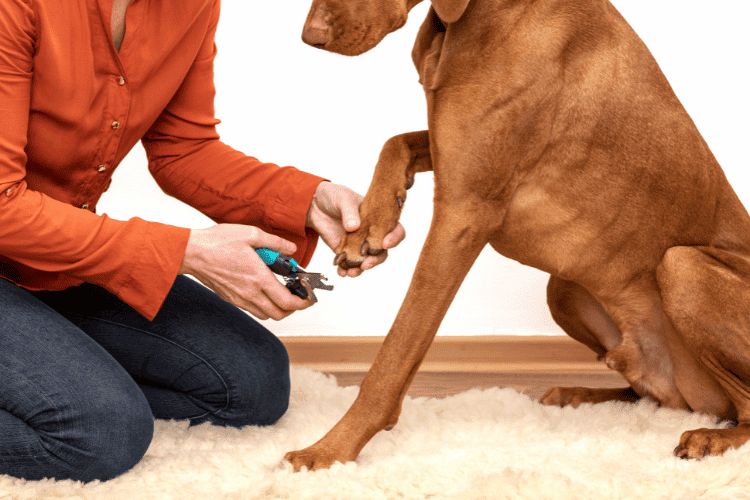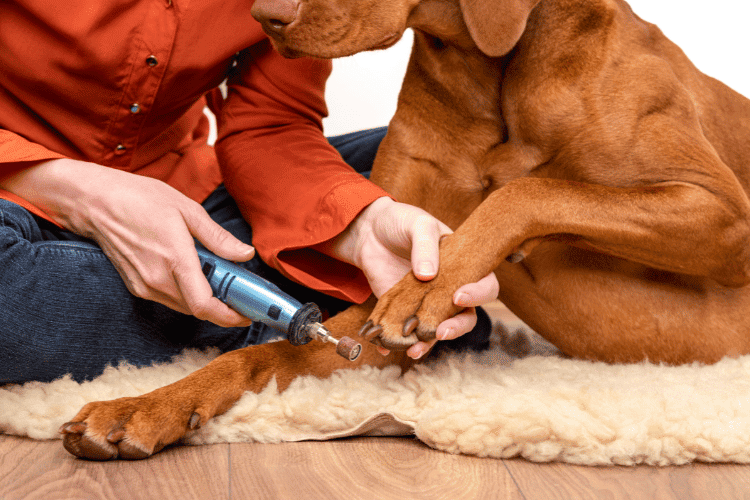When it comes to our furry companions, we often focus on their overall health and appearance, but one essential aspect of their well-being often goes unnoticed – their nails. Just like humans, dogs require proper nail care to ensure their comfort and overall health. Neglecting their nails can lead to pain, discomfort, and even serious health issues. In this guide, we will explore the Dogs nail anatomy, why nail care is crucial, and provide you with a step-by-step guide on how to keep your dog’s nails healthy and beautiful.
Understanding Dogs Nail Anatomy
A canine nail anatomy consists of three main parts: the claw, the quick, and the cuticle. The claw is the hard outer part of the nail, which is trimmed during grooming. The quick, a living tissue within the nail, contains blood vessels and nerves, appearing pink or red in light-colored nails. However, it can be harder to see in dark nails. The cuticle, similar to human nails, is a thin layer of skin that surrounds the nail’s base. Understanding these components is essential for proper nail care and grooming to ensure your dog’s comfort and well-being.
Why Canine Nail Anatomy Is Crucial
Proper doggy nail care is crucial for several reasons. Firstly, it ensures your furry friend’s comfort and mobility. Overgrown nails can cause pain, and bleeding and affect a dog’s intelligence and ability to walk or run. Secondly, it prevents injuries. Long nails are more prone to breakage, which can lead to pain and infections. Thirdly, it contributes to joint health. Long nails can alter a dog’s toe alignment, potentially causing joint problems. Additionally, it helps avoid infections, as dirt and bacteria can accumulate under overgrown nails. Lastly, nail care maintains balance, preventing slips and falls, particularly important for older dogs. Overall, nail care is essential for your dog’s well-being.
Black Dogs Nail Anatomy
Black nail anatomy dog is similar to that of other dogs, but it presents a unique challenge during grooming. The outer part of the nail called the claw, is hard and opaque. However, the quick, the living tissue inside the nail, can be challenging to spot in dark-colored nails due to its pigmentation. Care must be taken when trimming black dog nails to avoid cutting into the quick, which can cause dog nails bleeding and discomfort. Using a bright light or specialized tools designed for dark nails can make the process safer and more comfortable for your furry friend. Regular maintenance is essential for their well-being.
Dogs Nail Partially Ripped Off
When a dog’s nail is partially ripped off, it can be a painful and distressing experience for both the pet and the owner. This injury can occur due to accidents, getting caught in objects, or excessive nail length. Immediate action is necessary. First, clean the wound gently with warm water and apply an antiseptic. If there’s bleeding, apply pressure with a clean cloth or tissue to stop it. Then, visit your vet promptly. They can assess the damage, provide pain relief, and may need to trim the remaining nail. Proper care and attention to this injury will ensure your dog’s comfort and recovery.
Importance of Dog Toe Nail Anatomy
Understanding dog-toe nail anatomy is crucial for proper pet care. The toenails, composed of the hard claw, sensitive quick, and surrounding cuticle, play a vital role in a dog’s comfort and mobility. Neglecting them can lead to discomfort, pain, and mobility issues. Additionally, maintaining the right nail length is essential for preventing injuries, as long nails are more prone to breakage and can get caught on surfaces. Proper nail care also contributes to joint health by ensuring the toes align correctly. Regular inspection and care of dog toenail anatomy are fundamental for a happy and healthy canine companion.

Step-by-Step Guide to Dogs Nail Care
Now that you understand the importance of nail care for your furry friend, let’s dive into a guide on how to properly care for your dog’s nails:
- Gather Supplies: Before you begin, gather the necessary supplies, including nail clippers or a nail grinder, styptic powder (in case you accidentally cut the quick and cause bleeding), and treats for positive reinforcement.
- Inspect the Nails: Examine your dog’s nails to determine how much needs to be trimmed. Be cautious, especially if your dog has dark nails, as it can be challenging to see the quick. If in doubt, trim a small amount at a time to avoid cutting too close.
- Choose the Right Tool: You have two main options for trimming nails: nail clippers or a nail grinder. Clippers are best for dogs with thin or small nails, while grinders are more suitable for larger dogs with thicker nails.
- Trim Gradually: Trimming the doggy nail at a time. If you see a pinkish hue, stop cutting to avoid the quick. If you accidentally trim the quickly and bleeding occurs, use styptic powder to stop the bleeding.
- Shape the Nails: Use the nail clippers or grinder to shape the nails. Round the edges slightly to prevent sharp points that can scratch you or your furniture.
- Repeat on All Nails: Repeat the trimming process for all your dog’s nails, front and back. Remember to go slowly and take breaks if your dog becomes anxious or restless.
- Reward and Praise: After you’ve finished trimming, be sure to reward your dog with treats and plenty of praise.
- Regular Maintenance: Establish a regular nail care routine. The frequency of trimming will depend on your dog’s activity level and the rate of nail growth.
Dogs Nail Broke Off At Base: Dogs Nail Anatomy
When a dog’s nail breaks off at the base, it can be painful and potentially lead to bleeding. This situation usually occurs due to trauma or an accident. Immediate attention is needed to stop any bleeding and prevent infection. Gently clean the area with a mild antiseptic, and if bleeding persists, use styptic powder or cornstarch to help clot the blood. Consult your veterinarian for further guidance, as the exposed nail bed is vulnerable to infection. In some cases, your vet may need to remove the remaining nail or prescribe antibiotics to prevent complications. Proper care ensures your dog’s comfort and recovery.
Tips for Successful Anatomy of Dog Nail
Achieving successful dog nail anatomy is essential for your pet’s well-being. Here are some valuable tips to ensure proper nail care:
- Start Early: Introduce nail care to your dog as a puppy to acclimate them to the process.
- Be Patient: Take your time and don’t rush the procedure, especially if your dog is nervous.
- Regular Inspections: Check your dog’s nails regularly for signs of injury, infection, or overgrowth, even if they don’t need trimming.
- Use Positive Reinforcement: Reward your dog with treats and praise during and after nail care to create a positive association.
- Seek Professional Help: If you’re unsure or your dog has challenging nails, consult a professional groomer or veterinarian.
Normal Dog Nail Length: Pooch Talon Anatomy
Understanding the normal length of a dog’s nails is essential for their well-being. Ideally, a dog’s nails should be short enough that they don’t touch the ground when the dog is standing. If the nails are too long, they can cause discomfort, affect mobility, and lead to health issues. Long nails can also make it challenging for a dog to walk on slippery surfaces, potentially causing injuries. Regular trimming helps maintain the right length, preventing these problems. Additionally, keeping nails short ensures that they don’t curl or grow into the paw pads, which can be extremely painful for your furry friend.

Conclusion: Dog Toenail Anatomy
Proper nail care is an essential aspect of your dog’s overall health and comfort. By understanding the anatomy of a dog’s nails and following a step-by-step guide to nail care, you can ensure that your furry friend’s nails stay healthy and beautiful. Remember to be patient, use positive reinforcement, and seek professional help if needed. With regular care, your dog will enjoy a happier, more comfortable life, free from the pain and discomfort that can result from neglected nails.
FAQs
How often dog nails trimmed?
The frequency of dog nail trimming depends on the dog’s activity level and the rate of nail growth. In general, most dogs need their nails trimmed every 2-4 weeks. Regular inspections of your dog’s nails will help determine when it’s time for a trim. Breeds with fast-growing nails may require more frequent attention, while less active dogs may go longer between trims.
How many toenails does a dog have?
Dogs typically have 18 toenails, with five on each front paw and four on each back paw. Some dogs may have an additional “dewclaw” higher up on their front legs, which is essentially a fifth toe. The number of toenails can vary slightly among individual dogs and breeds. Regular toenail care is essential for their health and comfort.
Do dogs have nerves in their nails?
Yes, dogs have nerves in their nails. These nerves are present in the quick, which is the living tissue inside the nail. It contains blood vessels and nerve endings, making it sensitive. Care must be taken when trimming a dog’s nails to avoid cutting into the quick, as it can cause pain and bleeding.


